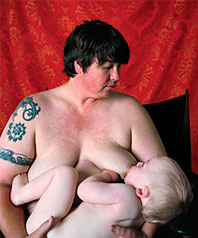
The opening of the Elizabeth A. Sackler Center for Feminist Art, in the Brooklyn Museum, is a formal act of recognition. Women have transformed the art world during the past 40 years, moving in great numbers into museums, galleries, faculties, and, most important, the studio. Many chose as their subject the cultural identity of women. From the first, as everyone knows, feminist art excited skywriting ideologues. Advocates, usually from the left, celebrated an art that radically recast the image of women. Detractors, usually from the right, found it tendentious. Both groups could, at times, bore a stone. Where art is concerned, the right and wrong of things always comes down to the individual work. But no one could deny that feminism changed art.
The actual center is a small exhibition and study space organized around Judy Chicago’s The Dinner Party. First exhibited in 1979, The Dinner Party consists of a large triangular table on which rest 39 place settings representing celebrated women from the past, ranging from “Primordial Goddess” to Virginia Woolf. Part of Brooklyn’s permanent collection, The Dinner Party is now installed in a dramatic space that has a reverential aura, a kind of expectant hush, as if women were about to take their rightful place at the great table of human history. To inaugurate the center itself, a large survey called “Global Feminisms” opened last week in both the Sackler and neighboring galleries. That show, organized by Linda Nochlin and Maura Reilly, includes work in a wide range of media by more than 100 young artists from 50 countries. As their provocative title suggests, Nochlin and Reilly don’t treat feminism as a monolith. They emphasize its plurality, variety, and difference. (It is one thing to be a feminist in the West, quite another to be one in a Muslim nation.) The survey is loosely divided into thematic sections called “Life Cycles,” “Identities,” “Politics,” and “Emotions,” areas of particular interest to artists who confront, expose, and attack cultural clichés about women.
By far the most powerful subject in the show, however—one that can overwhelm fine distinctions—is the presence of the visceral female body. Over the past four decades, artists have waged a furious struggle over the body, seeking to reclaim it from the usings and abusings of men in particular and society in general. The struggle is not pretty. Because iconic presentations of the female body are so slick and formidable, feminists have responded with iconoclastic intensity, asserting other views of the flesh in an aggressive, confrontational, in-your-face manner. They celebrate the imperfect; they highlight the lost, ignored, and damaged.
In just the opening room of the show, for example, viewers at “Global Feminisms” come upon (and this is not a full accounting) a plaster cast of an autopsied corpse, a baboon nursing a human child, several partially clothed women who appear to have been raped in the woods, Sylvia Plath with her head in the oven, a huge painting of bloated women, and an image of pregnant men. There’s much more to come: A video of a woman hula-hooping on a beach with barbed wire, for example, and several photographs of a woman’s head tightly bound in strings of blood-soaked pigskin.
Feminists have won the battle over the body, in art if not society. It’s now difficult to see an idealization of the female figure—in painting, advertising, or the movies—without recalling their work. Perhaps that’s why a disconcerting sameness is now developing in the feminist presentation of the body, despite the effort in this show to highlight differences. The sameness lies not in the details but in tactics, tone, and mood. Most images in the show are accompanied by a longish analysis in which words and phrases like the following are constantly repeated: “social construction,” “transgress,” “radical reinterpretation,” and, above all, “stereotype.” The slaughter of the stereotypes is everywhere. (I almost felt sorry for the stereotypes.) And that slaughter is becoming ritualized. The iconoclastic is developing into the iconic; the attack on stereotype is stereotypical. This happens all the time in art. With repetition, what was fresh grows stale.
Certain works in the show escape this paradox, opening unexpected ground for feminist art. Catherine Opie is a photographer well known for depicting socially marginal figures, and her wonderful Self-Portrait/Nursing—a riff on the Madonna-and-child theme—is steeped in the culture of stereotype and transgression. But she doesn’t use the customary devices. There is no shriek of the victimized, no crudely ironic takedown of the cliché. Instead, the carefully composed image is vital, even joyous in the wise and melancholy manner of all great Madonnas. The color of the boy, resting in Opie’s dark and beefy hands, is as translucent as ivory; he blushes as he draws in the milk. Opie’s picture comes to no conclusions about mother and child, innocence and experience, beauty and beast. It challenges convention by insisting upon a renewed feeling for the mysterious. Lin Tianmiao’s Self-Portrait, a filmy image of a head on which she’s embroidered countless knots, does something similar. It evokes much, says little. It whispers. “I am often called a Chinese woman artist,” she has said. “But I would rather say that ‘I am an artist, I am a woman, and I am Chinese.’ ”
The Dinner Party
Elizabeth A. Sackler Center for
Feminist Art at the
Brooklyn Museum.